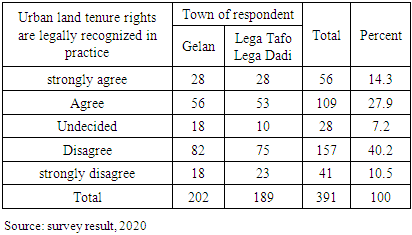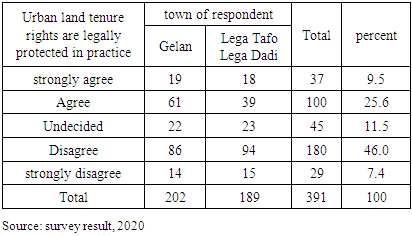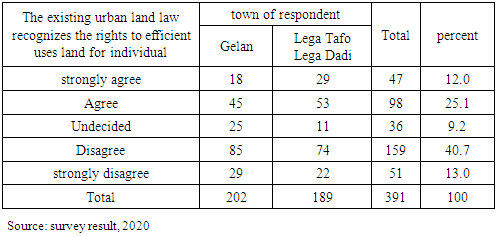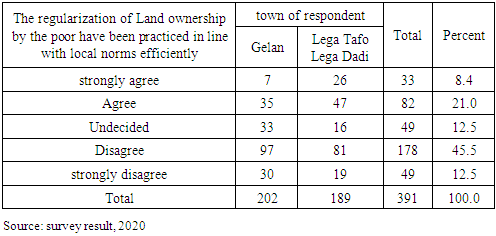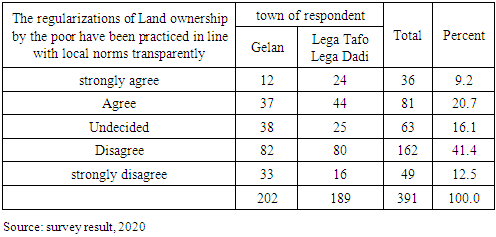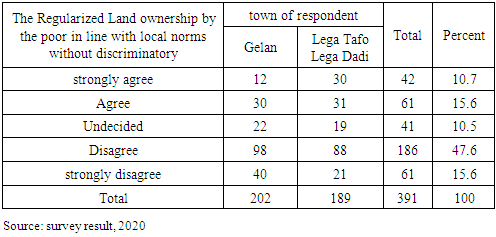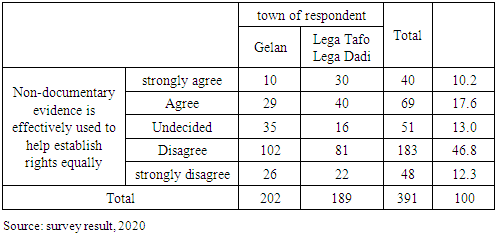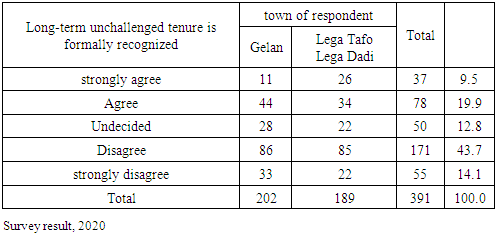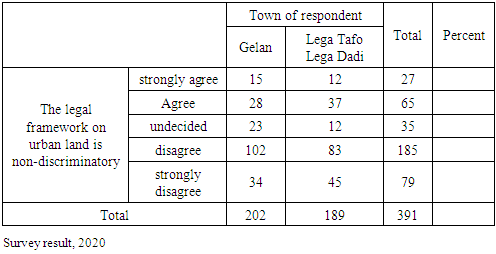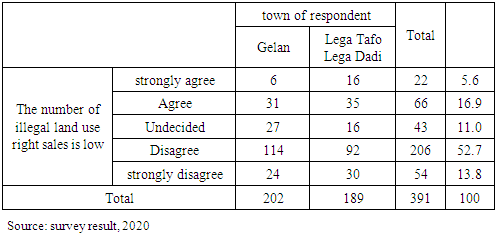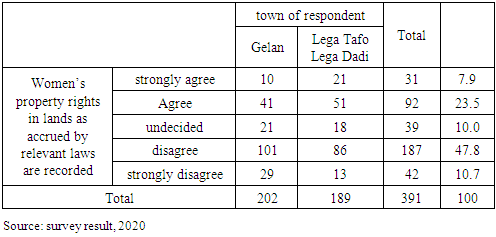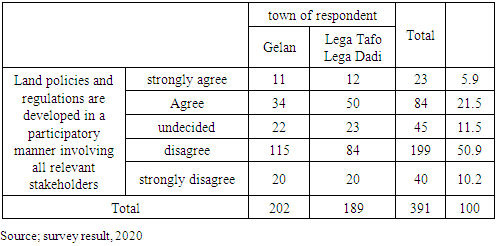-
Paper Information
- Paper Submission
-
Journal Information
- About This Journal
- Editorial Board
- Current Issue
- Archive
- Author Guidelines
- Contact Us
American Journal of Geographic Information System
p-ISSN: 2163-1131 e-ISSN: 2163-114X
2021; 10(1): 1-20
doi:10.5923/j.ajgis.20211001.01
Received: Dec. 6, 2020; Accepted: Jan. 22, 2021; Published: Feb. 26, 2021

Urban Land Management Legal and Institutional Framework from Governance Dimension - The Case of Gelan and Lega Tafo Lega Dadi Towns
Fraol Udessa, Dagnachew Adugna, Liku Workalemahu
Addis Ababa University, Addis Ababa, Ethiopia
Correspondence to: Fraol Udessa, Addis Ababa University, Addis Ababa, Ethiopia.
| Email: |  |
Copyright © 2021 The Author(s). Published by Scientific & Academic Publishing.
This work is licensed under the Creative Commons Attribution International License (CC BY).
http://creativecommons.org/licenses/by/4.0/

Urban land legal and Institutional frameworks, synchronized for effective urban land management in most developing countries are highly constrained, to promote efficient urban land management. Therefore these papers critically assess the extent of good governance practices in urban land management legal and institutional framework the case of Gelan and Lega Tafo Lega Dadi towns, Ethiopia. The research approach adopted is qualitative and quantitative. The strategy used is mixed-method and the instruments employed were questionnaires, face-to-face interviews, focus group discussion, documents reviewed. The quantitative data sets obtained were analyzed using SPSS and the qualitative data were analyzed using content analysis. The results revealed that the urban land management process approach to address the quest of weak governance in urban land management through functional legal cadastre designed by government practically does not implemented. Urban land tenure rights in part do not legally recognize and protected in practice due to the absence of legal framework and policy which define the identity of the aboriginal community related to urban land. Undefined land for the public purpose can’t encourage landholders to efficiently use their land since public land to be transferred to undefined private users in name of public purpose. Finally, the processes for recognition of land rights were not in line with the norms of the people and the mechanisms to stop illegal land sales increase the trouble of the communities involved in urban land transactions and, the decision-making process in land use plan at town’s level was not inclusive.
Keywords: Urban Land Management, Good Governance, and Legal and Institutional Framework
Cite this paper: Fraol Udessa, Dagnachew Adugna, Liku Workalemahu, Urban Land Management Legal and Institutional Framework from Governance Dimension - The Case of Gelan and Lega Tafo Lega Dadi Towns, American Journal of Geographic Information System, Vol. 10 No. 1, 2021, pp. 1-20. doi: 10.5923/j.ajgis.20211001.01.
Article Outline
1. Introduction
- Urban centers in developing countries have shown development and distribution of new settlements to be disorganized and making it very difficult for the development authorities to govern and manage such settlements as a result of varying factors. The United Nations Population Fund Projects (UNPF) has shown that sub-Saharan Africa’s urban population will double between 2000 and 2030 and this would take place in the urban areas (CIA, 2007). The problems of the urban areas to be envisaged as a result could include amongst others poor housing, poor basic infrastructure, poor environmental quality and urban land dispute. Generally bring about changes in the unique urban landscape of the settlements, urban management sytem, and urban socio economic development (Wapwera et al. 2015). These changes are evident as physical planning problems and can best be addressed by the transformation processes involving key aspects of urban management through land use planning using their policy guide. Failures of these have manifested in the numerous physical planning problems; Urban sprawl, slums and environmental degradation as observed in most developing countries such as India in Asia and Nigeria in Africa (Wapwera, S. D etal, 2015). The theory of Eminent Domain implies the right of the state to claim private property for state use. The principle underlying such gaining is that the appropriation must be for Public Purpose as it is called in Ethiopia. Land acquisition policy in combination with land use policy frames a set of land policy that is compliant to the major development goals which society strives to attain. Therefore, it is the political economy of development which ultimately shapes such land policy in urban development in the world. Land scarcity and demand in cities are also driving factors increasing the pressure on the governance of land management systems. Population growth and urbanization have a significant impact on driving up either value of land or land value which affects housing and property affordability for implementing planning functions and zoning regulations.Land management in Africa, particularly Sub-Saharan Africa has presented a variety of challenges due to its historical, social, political, and cultural diversity. High profile land grabs and illegal state land capture, land insecurity and lack of public participation in the land decision-making process are being exposed across several African nations. Like other African countries, urban land management practices across Ethiopia highlights worrying signs and indication of serious urban land management problems. Gelan and Lega Tafo Lega Dadi towns are no exception.Under the Federal Democratic Republic of Ethiopia, urban land is governed and administrated by the urban land leasehold law which has been amended three times since its first application in 1993 (proclamation. 80/1993, 272/2002, and 721/2011). On the other hand urban land-related laws like proclamations No.574/2008 and the No. 818/214 also included. All these legislations have primarily aimed to promote efficiency and effectiveness in urban land governance. However, the objective to promote good governance in urban land management appears to be a frightening statutory forecast due to gaps under the law itself and in the course of enforcement. Empirical studies indicate that urban land institutional and legal framework does not promote good governance in urban land and discourage the widespread unethical practices from the government (World Bank 2016). Survey results conducted on different Ethiopian cities i.e. Bahir Dar, Addis Ababa, Hawasa, Dire Dawa, and other cities in Ethiopia by Shewakena Aytenfisu (2016), Gizachew Birhanu (2016), Berhanu, et al, (2015), (Melesse et al. (2014) and Nigussie (2016) underlined that gaps and weaknesses in the legal framework widen opportunities for urban land management and land governance were generally weak and surrounded by a growing number of challenges. These include Lack of coordination of the existing institutions, insecurity of tenure and illegal land settlements, displacement, lack of societal participation in decision making, and weak capacity for enforcement and monitoring of laws and land use planning. Hence, the efficiency and effects of the urban land legal and institutional framework on urban land management at local government level is not clearly assessed yet. It would be significant if the Urban Land Management Legal and Institutional Framework implementation from Governance Dimension assessed at the local level. The choice of Lega Tafo Lega Dadi and Gelan towns because of these town’s are vibrant towns proximity and surrounding capital cities of Addis Ababa and which has the same administrative structure and administered under Oromia regional state. Therefore this paper examines urban land management institutional and legal framework from the governance dimension by focusing on urban land right recognition, enforcement of the land rights, restriction of land rights, and Civic engagement on the policy framework.
2. Related Literature Review
- Overview of legal and institutional frameworkGovernance and institutional issues are critical to urban land management in Africa, where institutional restructuring and decentralization are often undertaken due to the weakness of the state and the importance of improving good governance cited in Sintayehu D. (2016). Conventional urban land management systems, whether they are established for fiscal, multiple purposes, have four main elements, these are: land registration, cadastral surveying and mapping, land valuation and land-use planning (Dale and McLaughlin, 1999). These elements characteristic in many land management systems worldwide. A country's land management systems can be ordered in many ways and can take the form of a centralized, decentralized or integrated land management system. Centralized systems use a centralized bureaucracy to carry out land management tasks, thereby relying on a single, closed approach. In decentralized land management systems, different land management functions are diversified and shared among different agencies (Ibd). Good governance, efficiency and effectiveness feature prominently in integrated land governance as a means to ensure sustainable land management. The government of Ethiopia strongly conforms to the principles of decentralization. Ethiopia start to decentralized government system in 1991. In a while, the FDRE constitution paved the way for a democratic system of government whereby people at all levels could excercieto participate in political, social and economic affairs. Hence, the constitution attempts to encourage self-rule at all levels and involvement of the people in the formulation of improvement policies and programs. Following the decentralized governance system, regional states have established land management institutions with varied scope of responsibility. Furthermore, land management institution is understood as institutions, in urban areas, that are mandated in allocating land, protecting interests, solving disputes, planning, and managing the use of land. However the land recognition rights and enforcement procedures and public participation in urban land management in local areas does not examined yet.Governance in Urban Land ManagementThe concept of governance has become well-known when sustainability requires the concern of balancing social, economic, and environmental components in the decision-making process in few past decades. Urban Land governance concerns the set of rules, process, and structures via which decisions are prepared about access to urban land and its use, the means the decisions are made and enforced, the way that rival interests in urban land are managed (FAO, 2009). It contain state structures such as land management, courts, and municipalities responsible for the urban land. It also covers the legal and policy framework for land, as well as traditional practices governing land transactions, inheritance, and dispute resolution systems (FAO, 2009). Currently, the discussion about governance has continued in various disciplines, even though the definition and concept remain debatable (Olowu, 2002). In this line, Sheng (2010) as cited in Samsudin (2014) perceptively states that governance is a complex concept because it has been described in various ways and the concept of governance varies widely, which is one side debate may refer to the quality of the public delivery system for society and on the other side may concern about the development of the appropriate institutional framework. Land governance refers to the rules and the structures that rule and arbitrate relationships, decision-making, and enforcement of the decisions taken on urban land. The rules and structures of land tenure can be formal (i.e. Laws, regulations, and by-laws administered by parliaments, courts, and municipal councils) as well as informal or customary or a group of them (Temesgen, 2020).On the other hand, the word governance can be defined in a variety of theoretical dimensions. Governance in the urban land executive is very important in many areas, as land management, especially in developing countries, grows increasingly vulnerable to maladministration. Whether pit or grand Corruption is linked to weak governance in developing countries where having power over land is considered as a means of controlling political and economic power and privilege through fraud (FAO, 2007). Weak urban land governance is also linked to increasing insecurity in property rights and a soaring level of bribery and corruption in urban land management activities, particularly in the developing world. Studies conducted by Burns and Dalrymple (2008) in developing countries have witnessed that cities are unable to provide affordable urban land in sufficient quantities, particularly for the urban poor, because of inefficiency and ineffectiveness of land management. Regarding this, they pointed out that a Weak institutional and legal framework will affect the poor in particular and may leave them marginalized and outside the law.To evaluate Urban Land Management Legal and Institutional Framework from Governance Dimension requires precise and well-defined evaluation framework. According to K. Deininger, Selod, & Burns (2011), FAO (2007) and Word Bank (2013), the Land Governance Assessment Framework (LGAF) which was developed by the World Bank and its partners is one of the most well-known frameworks used to evaluate the good governances in the urban land management. Therefore, based on the objective of these studies the (LGAF) is used to assess Urban Land Management Legal and Institutional Framework from Governance Dimension. Because of, LGAF is one of the most comprehensive and diagnostic tool frameworks for the evaluation of urban land governance from in a different perspective.
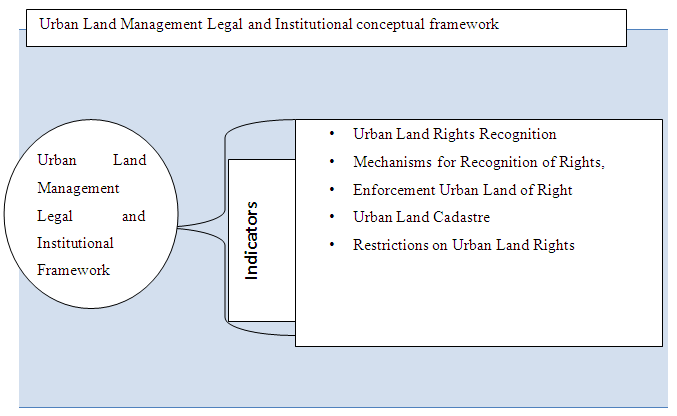 | Legal and Institutional Framework Governing Urban Land (Source; Adapted from world Bank (2007)) |
3. Research Methodology
- Overview of Study AreaGelan and lega Tafo lega Dadhi towns are emerging new cities. Gelan is located in Special Zone surrounding Finfinne in oromia regional state which located 25 km away from Addis Ababa in South-East direction or between 7°12’- 9°14’N Latitudes and 38°32’ – 39°32’ E Longitudes. Whereas Lega Tafo lega Dadi is also located in Special Zone surrounding Finfinne located 21 km away from Addis Ababa in the North-East direction. Gelan boundary is physically attached to Addis Ababa and Dukam and the total area of the City is 75.16 km2 (7516) hectares whereas lega tafo lega dadi town is bordered by Addis Ababa city and Sululta Wereda from the west and Northwest, by Berek Aleltu Wereda from the North, East and South with a total area of 7444.53 hectares. Currently, the population of Gelan town increase to male 31043 female 33687 total 64729 and Lega Tafo Lega Dadi town population also increase to male 17927 Female 22937 total 40864 (Lega Tafo lega Dadi and Gelan towns admin, 2019). Both towns were established after the establishment of some investments around and have been grown by displacing and affecting the livelihood of local farmers.The Maps of study areas
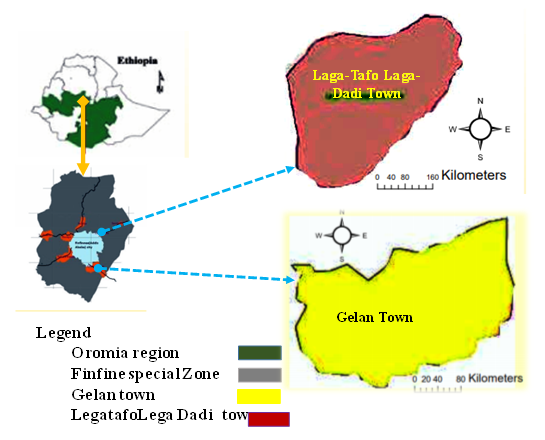 Research designThe study employed a qualitative and quantitative research approach to identify and understand gaps under the institutional and legal framework that brings weak governance in urban land management. The researcher selected the areas after critical observation and aims to assess the gap of urban land management legal and institutional focuses on national, regional, and town levels. Based on the aim to describe in detail the current performance of urban land institutional and legal framework, descriptive- case study types was employed. This research utilizes quantitative data generated by a cross-sectional survey questionnaire and qualitative data collected via key informant interview (structured interview) and focus-group discussion. In this study, quantitative data was measured using a Likert scale.Sample Technique and SizeNon-probability and probability sampling techniques were employed to select samples from the population. The researchers purposely selected the key informants: from each towns, mayors, land management officials, each towns head of judicial in each town, four kebele officials from each town, investment offices and one 2 land experts, 2 urban planners expert, from each town were interviewed and totally 24 officials and experts were interviewed. From probability sampling, the researchers used systematic random sampling to identify respondents from each town and kebeles. The study population for this research consisted of the heads of households in two towns. According to the data obtained from Gelan and Lega Tafo Lega Dadi town administrations, their household numbers were Gelan 8722 and L/ Tafo L/Dadi 8173, a total of 16,895 and researchers would use Yamane’s formula (1967), therefore, the sample size of household respondents would be determined by using the following formulan= N/(1+N(e)2) n=391.The sample size for each town will be determined from the total sample size based on the household size of each town by the stratified sampling formula• ni= (n/N)Ni where,Henceο Gelan = (391/16,895) 8722 = 202ο L/ Tafo L/Dadi = (391/16,895) 8173 = 189• Therefore 391 sample representatives would be considered in two towns as a respondent in survey questionnaires. Selecting a random starting point for independent household K = N/n. the formula would be used. Besides researcher adds 20% of a sample size to increase the rate of return i.e 391*20/100= 78 questionnaires were distributed in addition to the determined sample size.Data Analysis MethodThe qualitative and quantitative data collected from respondents were analyzed descriptively. In the process of mixed data analysis, qualitative data analysis was dominantly employed. Three hundred ninety-one (391) questionnaires were distributed to head of households and all questionnaires were returned and entered to SPSS version 20 for the statistical analysis. The result of statistical analysis is presented using percentages; tables and graphs while data collected through interviews, secondary data, and focus group were analyzed through interpretation, narration, and content analysis, and finally data collected through interview, focus group discussions, and questionnaires were triangulated.
Research designThe study employed a qualitative and quantitative research approach to identify and understand gaps under the institutional and legal framework that brings weak governance in urban land management. The researcher selected the areas after critical observation and aims to assess the gap of urban land management legal and institutional focuses on national, regional, and town levels. Based on the aim to describe in detail the current performance of urban land institutional and legal framework, descriptive- case study types was employed. This research utilizes quantitative data generated by a cross-sectional survey questionnaire and qualitative data collected via key informant interview (structured interview) and focus-group discussion. In this study, quantitative data was measured using a Likert scale.Sample Technique and SizeNon-probability and probability sampling techniques were employed to select samples from the population. The researchers purposely selected the key informants: from each towns, mayors, land management officials, each towns head of judicial in each town, four kebele officials from each town, investment offices and one 2 land experts, 2 urban planners expert, from each town were interviewed and totally 24 officials and experts were interviewed. From probability sampling, the researchers used systematic random sampling to identify respondents from each town and kebeles. The study population for this research consisted of the heads of households in two towns. According to the data obtained from Gelan and Lega Tafo Lega Dadi town administrations, their household numbers were Gelan 8722 and L/ Tafo L/Dadi 8173, a total of 16,895 and researchers would use Yamane’s formula (1967), therefore, the sample size of household respondents would be determined by using the following formulan= N/(1+N(e)2) n=391.The sample size for each town will be determined from the total sample size based on the household size of each town by the stratified sampling formula• ni= (n/N)Ni where,Henceο Gelan = (391/16,895) 8722 = 202ο L/ Tafo L/Dadi = (391/16,895) 8173 = 189• Therefore 391 sample representatives would be considered in two towns as a respondent in survey questionnaires. Selecting a random starting point for independent household K = N/n. the formula would be used. Besides researcher adds 20% of a sample size to increase the rate of return i.e 391*20/100= 78 questionnaires were distributed in addition to the determined sample size.Data Analysis MethodThe qualitative and quantitative data collected from respondents were analyzed descriptively. In the process of mixed data analysis, qualitative data analysis was dominantly employed. Three hundred ninety-one (391) questionnaires were distributed to head of households and all questionnaires were returned and entered to SPSS version 20 for the statistical analysis. The result of statistical analysis is presented using percentages; tables and graphs while data collected through interviews, secondary data, and focus group were analyzed through interpretation, narration, and content analysis, and finally data collected through interview, focus group discussions, and questionnaires were triangulated.4. Research Findings and Discussion
- This paper examines urban land management institutional and legal framework from the governance dimension by focusing on urban land right recognition, enforcement of the land rights, restriction of land rights, and Civic engagement on the policy framework. Hence, the efficiency and effects of the urban land legal and institutional framework on urban land management at the local government level of Lega Tafo Lega Dadi and Gelan towns were assessed as follows.
4.1. Urban Land Rights Recognition
- The legal recognition of existing land rights is a key element of good land governance in urban land management. But in the study area failure to define urban land rights, including individual, traditional, or other types of group rights, create tenure insecurity, reduce investments in land, increase the potential for conflict, and blocking urban land to more efficient uses. The detail of legal recognition of existing urban land right discussed as follows
4.1.1. Aboriginal Rights to Urban Land
- Currently in Ethiopia cities or towns including study areas, there is no legal framework or policy which defines and preserves the identity/ culture of the aboriginal community related to urban land. Recently there are directives from the federal government related to the kept existing rights during expropriation which is not implemented and legally recognized. The interview conducted indicates that aboriginal communities are often marginalized and vulnerable to social, cultural, and political problems that they have following the establishment of the town. The lives and livelihoods of Oromo communities in the study areas especially those lives close to Addis Ababa cities continue to be found at risk by urban land management and federal and Oromia regional state government allocating land for urban residents and eager to attract investment, without taking an account of the costs of aboriginal’s communities. On the contrary, as part of the legal framework enacted at federal and regional levels considered as all land rights of landowners are recognized. All landholder’s tenure rights are legally recognized as holders of the lands under their ownership. On the other hand, indigenous communities reside around and in the town areas, their land rights are ignored and disproportionately affected by government compulsory expropriation of land in the name of public purpose/investment by losing their land rights. Doubtfully Ethiopia is rich in ethnic diversity with various cultures and norms to land relation reveals, whereas there is no separate legal provision that defines the protections of those people to land rights. As a result of proximity to Addis Ababa and the high expansion of urban areas, residents of study areas become highly affected by socio-economic problems. For instance, since 2016 the states granted 866.6 hectares of land for the last 5 years in Gelan town to various purposes including different companies and investors. According to data obtained from Gélan town (2020) Over 436 households and 2180 families were already displaced from their land. Besides Interviews conducted with the key informants, groups revealed that displacement disrupts community structures and traditions, and means the loss of sacred and cultural sites. Generally, aboriginal rights are not recognized and not protected in practice in study areas. These practices seemed contradictory to the international human rights of aboriginal peoples which Ethiopia is obliged to respect and protect.
4.1.2. Urban Land Tenure Rights
- The FDRE 1995 constitution maintained the state ownership of the land and under the issuance of the constitution, the mode of urban landholding changed: an urban land leasehold system was enacted in 1993 by proclamation 80/1993 (TGE 1993) which allowed the sale, transfer, mortgage, and rent of urban land. This law was repeatedly changed by proclamation 272/2002 (FDRE 2002) and proclamation 721/2011 (FDRE 2011).Currently, the urban land tenure system for urban areas is broadly dealt with by the Urban Lands lease holding Proclamation No. 721/2011. It declares that all land in urban areas shall be transferred into the lease system which sustains the repealed proclamation No 272/2002 provisions means of land acquisition. Urban land lease law considers five means of urban land acquisition like an auction, negotiation, assignment, award, and lot. The municipal data shows that in study areas, auction/public sale is still the most utilized method to transfer land from urban land banks to investors because it helps increase the income of the town. Besides, the birthright/ inheritance are also one means of land and real property acquisition in study areas which practically implements when cases happened. However, the auction modality urban land transfer majority of the urban communities unable to afford. Currently to overcome this inefficiency of the land delivery Oromia regional state encourages the urban communities to start to co-operate the housing system by asking lease initial price to become the owner of residential land which is again unaffordable for the majority and may benefit middle-income level communities. This magnifies the motivation of urban residents to employ the informal way of accessing land. The interview with key officials shows that the informal settlers illegally purchased land either from the urban fringe residing farmers, or speculators, or encroachers or squatting on public land by force. As indicated in table 1.1 the respondents were asked to rate their view on whether all Urban land tenure rights are legally recognized in practice. Accordingly, 157(40.2%) and 41 (10.5%) respondents were replied to disagree and strongly disagree, while 109(27.9%) and 56 (14%) respondents were replied agree and strongly agree and 28(7.2%) respondents replied undecided. Thus, from table 1.1 it can be stated that the majority of 157(40.2%) respondents were confirmed that all urban land tenure rights were not legally recognized in practice.
|
|
4.1.3. Urban Land Transaction Rights
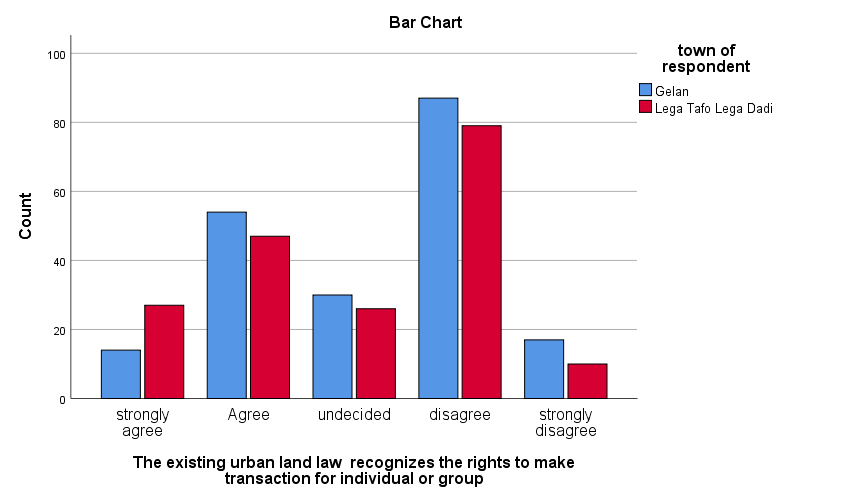 | Figure 1.1 |
4.1.4. Urban Land Rights to Efficient Uses
- According to land lease proclamation 271/2011, there are no laws that recognize the rights to efficiently use the land for individuals or groups occupied through illegal. An interview conducted with key informant group and FGD made with the urban community revealed that informal settlers in urban areas face tenure insecurity until probability enters into a lease through regularizing their land-use rights. Therefore illegal land settlers in the urban fringe surrounding area either is through informal association or individually based squatting cannot efficiently uses their land until probably gets land use rights. As indicated in table 1.3 the respondents were asked to rate their view on the existing urban land law recognizes the rights to efficient uses land for the individual. Accordingly, 159(40.7%) and 51(13%) respondents were replied to disagree and strongly disagree, while 98(25.1%) and 47(12%) respondents were replied agree and strongly agree and 36(9.2%) respondents replied undecided. Thus, from table 1.3 it can be stated that the majority of 159(40.7%) respondents were confirmed that the existing urban land law unrecognized the rights to efficient uses land for the individual.
|
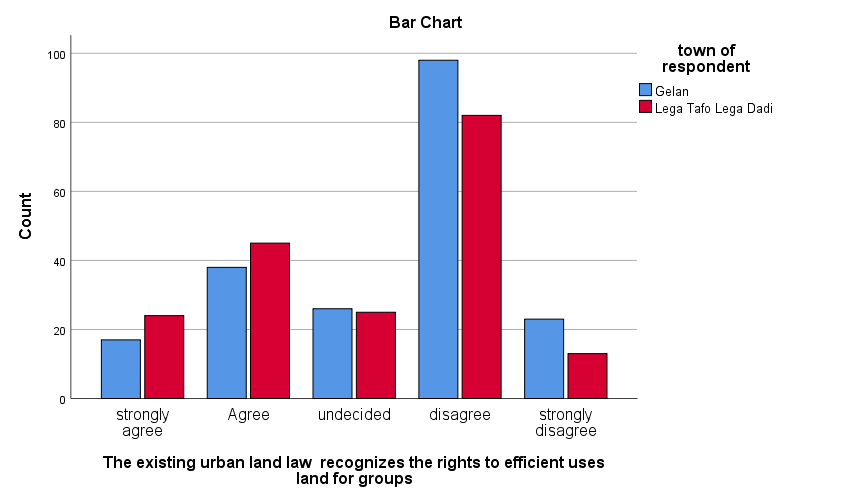 | Figure 1.2 |
4.1.5. Urban Land Uses Rights as Collateral
- Under proclamation no.721/2011, article 24(4), market-based increment in land value is not considered for collateral purpose while building and its accessories constructed on a leasehold as well as the use right is subject to collateral. The regulation on mortgage restriction is enforced. As per Proclamation No. 721/2011 article 24 (6), a building constructed on leasehold and its accessories shall be subject to the collateral where the right to the use of urban land is made as collateral or transferred. As per proclamation no.721/2011 as per article 24, (4), market-based increment in land values is not considered for collateral purposes. Therefore the recognition of existing urban land law recognizes the use of the rights as collateral for individuals or groups but the increment in land values is not considered for collateral purposes.
4.2. Mechanisms for Recognition of Rights
- The systematic process of regularization or ways to upgrade tenure on a demand-driven basis is needed, and mechanisms to do so should be affordable, transparent, and consistent with existing tenure practices. But in study areas existing urban land rights are weak; using an irregular approach for the registration of rights increases the risk of urban land being concentrated in the hands of well-connected and powerful elites. The detail of Mechanisms for urban land recognition of rights discussed as follows
4.2.1. Regularization of Urban Land Use Right
- The federal land framework law, based on the constitution, defines holding right as the right of any peasant farmer, urban resident, to use the land for agriculture and natural resource development. It allows them to lease and to give the land to members of his family or other lawful heirs. It includes the right to acquire property produced on his land by his labor or capital and to sell exchange and bequeath the same (FDRE, 2005) (Article 5/1). As indicated in table 2.1. The respondents were asked to rate their view on whether the regularization of urban Land ownership by the poor has been practiced aligns with local norms efficiently. Accordingly, 178(45.5%) and 49(12.5%) respondents were replied to disagree and strongly disagree, while 82(21%) and 33(18.4%) respondents were replied agree and strongly agree and 49(12.5%) respondents replied undecided. Thus, from table 2.1 it can be stated that the majority of 178(45.5%) respondents were confirmed that the regularization of Land ownership by the poor was not enforced to align with local norms efficiently.
|
|
|
4.2.2. Non-Documentary Evidence Use Urban Land Rights
- The implementation of a land management system requires the definition of this boundary. In addition to defining the boundary of urban land on which the group right is exercised the definition of the beneficiaries or group members is another delicate issue that requires trials and pilots. Landholders are the key sources of information to confirm informal rights on the land. Public hearings used to be efficient tools in study areas were expected to be equally important in the local community especially those demarcated in urban areas. Public hearings as a tool for recognizing non- documented evidence and the use of (elders) to connect the informal rules to the formal legal system. Some formalization of the urban lands also depends on the duration of the time which once includes all informal settlers also considered as no documentary evidence in urban areas. Small scale farmers who demarcated to urban boundary their land before they got a book of holdings are issued to them had no documentary pieces of evidence to prove. The only evidence that can be presented by the landholders was tax receipts in urban areas. The tax receipts were assumed as the proof for the use of the land for the particular taxation period. As indicated in table 2.4 the respondents were asked to rate their view on Non-documentary evidence is effectively used to help establish rights equally. Accordingly, 183(46.8%) and 48(12.3%) respondents were replied to disagree and strongly disagree, while 69(17.6%) and 40(10.2%) respondents were replied agree and strongly agree and 51(13%) respondents replied undecided. Thus, from table 2.4 it can be stated that the majority of 186(47.6%) respondents were confirmed that Non-documentary evidence was not effectively used to help establish rights equally.
|
4.2.3. Long-Term Urban Land Tenure Rights
- The landholding system in Ethiopia does not include land ownership rights. The recognition of long-term unchallenged possession is not connected to holding right on the urban land. Slums and informal settlements are common in urban areas. The informal settlements in urban areas can be both legal and illegal. The long-term illegal possessions by squatters in different municipalities used to be destroyed sometimes even using force. As indicated in table 2.5 the respondents were asked to rate their view on the Long-term unchallenged tenure is formally recognized. Accordingly, 171(43.7%) and 55(14.1%) respondents were replied to disagree and strongly disagree, while 78(19.9%) and 37(9.5%) respondents were replied agree and strongly agree and 50(12.8%) respondents replied undecided. Thus, from table 2.5 it can be stated that the majority of 171(43.7%) respondents were confirmed that Long-term unchallenged tenure was not formally recognized.
|
4.3. Enforcement Urban Land of Right
- An increased frequency of urban land transfers makes urban land becomes more valuable, and then the Enforcement of urban land rights has to put existing rights or transfers rights in low-cost mechanisms. The detail of the enforcement of urban land right discussed as follows
4.3.1. Accessible Opportunities for Tenure Individualization
- Formalization of urban residential housing does not feasible and affordable because there are many problems from identifying the non-document evidence among the urban areas which very vulnerable to pet corruption. The requirements for regularized housing in urban are unaffordable and many applicants of the informal settlement were not to make happy with the requirements. The regularization regulation and strategy enriched with participatory tools injected at each stage of the process by including regular community meetings of the public in the process and community-centered grievance handling mechanisms are the missing important stages in the study areas. As indicated in table 3.1 the respondents were asked to rate their view on the legal framework on urban land as non-discriminatory. Accordingly, 185(47.3%) and 79(20.2%) respondents were replied disagree and strongly disagree, while 65(16.6%) and 27(6.9%) respondents were replied agree and strongly agree and 35(9%) respondents replied undecided. Thus, from table 3.1 it can be stated that the majority of 185(47.3%) respondents were confirmed that the legal framework on urban land was discriminatory.
|
4.4. Urban Land Cadastre
- Urban land management is a key intervention area to determine the tenure, use, and value of urban land through the establishment of a legal cadastre in the 2nd GTP period in Ethiopia. According to five years of strategic plan assessments by Oromia land bureau and towns, administrations' complex challenges are existing in urban land-related issues. The assessment underlined that the lack of clear and coordinated land development and management system has been a major bottleneck for the development of the country as general and study areas as particular urban centers. The document further elaborated the main feature of urban land management in town administrations is manifested by lack of secure, accurate, up-to-date, modern, and efficient land registration and information systems that affect mainly land and property transaction, weak land tax system and further results in distortion of urban land and property market. There exists a lack of up-to-date and complete maps to provide the required information on urban boundaries, urban land use, and cadastral index maps. As such, decisions on future urban developments are usually based on incomplete information. Urban Land and property transactions are made costly and slow due to complicated and time-consuming procedures. In some issues, Land tenure rights are often unclear, which can result in significant court case costs. Due to poor planning and implementation strategies little has been achieved to solve the revealed problems related to establishing a complete urban cadastre and land registration systems as general.The survey result revealed that in study areas the implementation of a cadastral project to register all property owners of land and landed properties could not start to be valued and taxed yet. Whereas rapid urban expansion in the towns escalated the demand for additional spaces for new development and the supplies are far behind to meet the ever-growing demand. This contributed to the growth of slums, informal settlements, and state land encroachment around the peripheries of the town administration, Ababa city boundary, and Lega Tafo Lega Dadi and Gelan town. In response to this, the regional land cadastre project bureau in collaboration with Gelan and Lega Tafo town administration lately attempt to implement the cadastre which is not implemented yet. However, it is found that the implementation of such projects is so challenging without having reliable, consistent records-keeping systems for real property rights that define who owns what, when, and where. Nonetheless, the regional state has identified the implementation of a cadastral surveying and land registration project in all towns and cities that have more than 20,000 inhabitants in the coming few years including Gelan and Lega Tafo town which still do not put into practice. Therefore all individual land in urban areas is not recorded and mapped.
4.4.1. The Illegal Urban Land Sale
- In principle, the land sale is forbidden by the FDRE constitutional law. According to the survey result out of 391 in study areas, 69% of household respondents acquired land through the purchase. Although this figure is not significant compared with other means of land acquisition, it revealed the existence of the practice in urban areas.Contrary to this, the large majority of the farmers delaminated to the urban periphery prefer to sell land illegally, rather than compensate by the government. Because the compensation given by municipal is less than the land sold through the informal transaction. For instance data from the focus group, the discussion indicates municipal that compensation given for land per meter square does not adequately change the life of displaced societies thus why landholders prefer to sell through informal transactions than state compensation.
|
|
|
4.4.2. Illegal Urban Land Transaction
- Though land markets are underdeveloped in the urban centers of Ethiopia a significant amount of capital money transacts in the economy. Since the enactment of the 271/2011 lease law, it is becoming obvious that determining the price of a ground lease by the bidding system improves the involvement of the urban land lease market in study areas. As indicated in table 4.4 the respondents were asked to rate their view on the number of illegal lease transactions is low. Accordingly, 208(53.2%) and 33(8.4%) respondents were replied disagree and strongly disagree, while 56(14.3%) and 29(7.4%) respondents were replied agree and strongly agree and 65(16.6%) respondents replied undecided. Thus, from table 4.4 it can be stated that the majority of 208(53.2%) respondents were confirmed that the number of illegal lease transactions was high.
|
4.4.3. Women’s Property Rights in Urban Lands
- One of the underlying public policy principles of the Government of Ethiopia stipulates that all interventions have to be gender-sensitive and can ensure equitable development for all women and men. Consistent with these public policy principles, Article 35 of the Ethiopian Constitution (1995) restates principles of equality of access to economic opportunities, including the right to equality in employment and land rights. During the implementation phase of land rights’, cadastral surveys, and registration women’s land rights sought a high level of attention and care at the policy level. Moreover, all federal and regional land laws boldly recognize women’s land rights equal to men. But in practice, there is a limited number of women who participated in landholders' urban area and there is no affirmative action has been taken place to make them benefit. For instance, according to data shows in Lega Tafo Lega Dadi town only 59 women got residential land in 2016-2020. These data show that the women don’t benefit from urban land delivery accord to the policies set principles.
|
4.5. Restrictions on Urban Land Rights
- The government can impose limits on the types of rights or how these rights can be exercised by individual right holders, such limits should be based on a careful assessment of the cost and benefit of different options, should aim to achieve desired environmental, health, security and other impacts at low cost, and should not disproportionately affect certain groups of right holders. But in study areas, urban land restrictions are beyond the reach of large portions of right holders and were not consistent with principles of good land governance. The detail of restrictions on urban land rights discussed as follows
4.5.1. Restrictions on Urban Land Transferability
- According to FDRE article 40 of the constitution, the right to ownership of urban and rural land is vested in the state; accordingly, the government has to take urban land through expropriation and restricts its use via urban land use planning and management process. Limitations on urban land ownership and transaction on the FDRE constitutions, article 40(3), it is officially enforced that urban land shall not be subject to other means of exchange. In the same manner, article 40(3), the right to ownership of rural and urban land is exclusively vested in the state and peoples of Ethiopia. The regulatory restrictions on ownership and sale of land by owners entitled with use right have provided a range of benefits in urban development and redevelopment, easier for infrastructure installation, securing land for social and physical infrastructure through the state power of an eminent domain. Yet, the restrictions have imposed legal uncertainties forgive resources on the part of the owner due to insecurity which in turn impacted private investment and the development of the financial market that are essential for economic development. As indicated in table 5.1 the respondents were asked to rate their view on the restrictions regarding urban land transferability effectively serve a public purpose are enforced. Accordingly, 186(47.6%) and 49(12.5%) respondents were replied to disagree and strongly disagree, while 82(21%) and 28(7.2%) respondents were replied agree and strongly agree and 46(11.8%) respondents replied undecided. Thus, from table 5.1 it can be stated that the majority of 186(47.6%) respondents were confirmed that Restrictions regarding urban land transferability effectively serve public purpose was not enforced.
|
4.5.2. Restrictions of Urban Land Ownership
- The urban landholding registration proclamation no.818/2014 article 4(1) recognizes uniform protection of landholding rights of private, joint holders, associations, and government and non-government institutions and article 30,(1) recognize the registration of all rights, restrictions, and responsibilities of old possessions and lease holdings concluded with the appropriate government body in the course of the creation of landholding right.The regulation does not recognize the registration of informal settlements unless administered through the lease holding administration. Besides registration does not recognize lately formed squatters contravening the lease proclamation and regulation.Therefore Owner types don’t comprehensively included the registration of informal settlement and lately formed squatter settlement unless administered under the lease system.Furthermore As per proclamation no. 721/2011, article 6, (2), when parceling of plots of urban land under the approved national standard and urban plan, in the course of converting old possession into leasehold under sub-article 1 of this article results in the reduction or increase of the size of the plot. As per proclamation no. 721/2011, article-6,(4,) to regularize possessions held without the authorization of the appropriate body, the possessions which have to be found acceptable following the urban plan and parceling standards following regulations to be issued by the city administrations shall be administered in lease holdings. According to the above proclamation and articles, chartered cities and the region have developed regulations for limiting minimum and maximum parcel size as per standards in their context which is not uniform in practice within the town found under the same regional states. Therefore the minimum and maximum parcel size restriction for replacement land for those properties liable for expropriation vary from one town to the others. For Gelan (105-500m2), and Lega Tafo (160-500 m2) while in case of land expropriation for a public purpose, there is a restriction on parcel size provided as replacement land for those relocated due to redevelopment.The regulation enforces parcel size restriction and the severity of restriction is high for informal settlements contravening planning regulations and for those owners relocated to other parts of the town due to urban expansion. The regulation on parcel size restriction is not fully enforced practically as stated in a rule adopted by the town. The survey result shows that; the parcel size of some proprietors could be greater than the restriction maximum size. For instance the case of Lega Tafo some residents even though they are informal settlers, but acquire land in the name of non-document evidence about 500m2 while the maximum parcel size as per regulation based on the duration of occupation for informal settlers is 200m2. Finally, the restriction on ownership and sale of land by private owners has benefited from expropriating land for social and economic infrastructure. While, on the contrary, the restriction has imposed legal uncertainties for committing resources on the part of the owner with a fear of insecurity of tenure, eviction, loosening of social bondage, increase affordability cost for the poor as they are relocated on the periphery. Therefore Restrictions regarding urban land ownership effectively serve public purpose were not enforced.
4.5.3. Restrictions of Urban Land Use (Disaster Risk)
- Survey result indicates that on the restricted zone of the urban land use plan (risk-prone areas), consolidated settlements are seen and squatter settlement is increasing from time to time in urban areas. For instance, both Gelan and L/ Tafo L/ Dadi towns do not provide any deed for risk-prone areas accommodated as per regularization specifying as the restriction in the master plan. In both towns neither in the process of resettling nor resettled the people informal settle and squatter in areas. Basically on land use planning, restricted zone risk-prone areas officially identified are supposed to restrict but in practically building /informal settlement are seen in open space, buffer zone, green areas, and the others. Informal settlements and squatters are seen in areas allotted for green areas and open space as per statutory urban plan. Furthermore, the interview made with experts of land management indicates that both town administration some either urban manager have no in detail awareness of the risk-prone or intentionally allow to abuse the areas of risk-prone in the land use plan implementation. So according to my observation and interview made with key informant groups both town administration has no plan to resettlement the informal occupiers and restricted plan to protect any informal settlement in urban areas, accordance with the land use plan statutory. Therefore Restrictions regarding urban land use did not effectively serve public policy objectives.
4.6. Civic Participation on the Urban Land in the Decision-Making Process
- Urban Land management institutions and the procedures they perform depend on the degree to which the policy framework guiding institutional practices is backed by the public consensus rather than by the view of them being controlled by powerful groups. But in study areas, there was weak community participation and ways to measure progress toward achieving urban land policy goals and the clarity of mandate for monitoring and publicizing progress toward achieving those goals and understood by those affected. The detail of Civic engagement on the policy framework discussed as follows
4.6.1. Land Policies and Regulations Development
- According to the FDRE Constitution, 1995 (Art.51/5) empowers the federal government to enact laws for the utilization and conservation of land and other natural resources whereas according to art. 52(d) the regional states have the power to administer land and another natural resource according to federal laws. Therefore the enactment of land laws and policies vested in the hands of the federal government. As indicated in table 6.1 the respondents were asked to rate their view on the Restrictions regarding urban land transferability effectively serve a public purpose are enforced. Accordingly, 199(50.9%) and 40(10.2%) respondents were replied to disagree and strongly disagree, while 84(21.5%) and 23(5.9%) respondents were replied agree and strongly agree and 45(11.5%) respondents replied undecided. Thus, from table 6.1 it can be stated that the majority of 199(50.9%) respondents were confirmed that Land policies and regulations were not developed in a participatory manner involving all relevant stakeholders.
|
4.6.2. Urban Land Right and Use Information
- The urban land policy shall be prepared, the preparation of land policies and laws needs to take reasonable time for consultation, and seek comments through a thorough involvement of relevant stakeholders is very essential. According to the interview made with the local communities and experts of the urban land sector, the implementation of the land laws is not regularly be supervised by lawmakers and responsible bodies. As indicated in table 6.2 the respondents were asked to rate their views on the Land right and use information is shared by public bodies are regular reports are publicly accessible. Accordingly, 159(40.7%) and 52(13.3%) respondents were replied to disagree and strongly disagree, while 102(26.1%) and 33(8.4%) respondents were replied agree and strongly agree and 45(11.5%) respondents replied undecided. Thus, from table 6.2 it can be stated that the majority of 159(40.7%) respondents were confirmed that Land rights and useful information was not shared by public bodies regularly reports and not publicly accessible. thus it affects the urban land management efficiently work.
|
5. Conclusions
- The government set out policy direction and designed strategies to play a positive role in improving urban land governance to address the quest of tenure security through functional legal cadastre designed by the federal and regional government almost does not implement in study areas. Urban land tenure rights partially do not legally recognize and protected in practice. In federal and regional states and study areas particularly, there is no legal framework and policy direction that define the culture of aboriginal community related to urban land, hence aboriginal communities are often marginalized and vulnerable to social, cultural, and economic problems. Regardless of urban land law recognizes the rights to make transactions for individuals or groups with some restriction of transfer price legally exist but not enforced by town administrations. Undefined land for public purpose also does not encourage landowners to efficiently use their urban land since most public land can be transferred to undefined private uses. As per proclamation no.721/2011 as per article 24(4), market-based increment in urban land values is not considered for collateral purposes. Shortage of qualified personnel operating, material, and resources are very challenging in the implementation of urban land tenure in town administrations.The process of Mechanisms for recognition of rights was not aligning with the norms of the people. There was no clear, practical process for the formal recognition of possession compromising the poor people and in line with local norms in efficiently and transparent process. When the non-document evidence land does not align with the proposed land use planning it does not suppose to uses as establishing the right and compensated.The Enforcement of rights through the formalization of urban residential housing is not feasible or affordable because there are problems of identifying the informal or non-document evidence among the urban areas which very vulnerable to pet corruption. The requirements for formalizing housing in urban areas process is long and in some cases not clear, affordable but many applicants from informal areas complaining about the town for the long process and bureaucracy in the sector. The mechanisms practiced by the institutions to stop illegal settlement expansion seem too unacceptable among the urban communities and actors involved in these transactions. As a result of illegal land scramble increase from time to time because individual land in towns was not recorded and mapped. One of the employed mechanisms is the use of coercion approach which forcefully demolished illegal building in towns, these results in socio-economic crisis in urban land management and causes governance problems.Restrictions on rights on ownership and sale of land by private owners have benefited from expropriating land for social and economic infrastructure. Contrary, the restriction has imposed legal uncertainties for investment properties on part of the landholder with a fear of insecurity of tenure, eviction, loosening of social bondage, unfair compensation, and relocation on the periphery. The government enacted a proclamation for restricting transfer prices for underutilized land to discourage speculators. Nonetheless, the government has failed to stop speculation as the transaction is executed through smart and binding dealing mediated by brokers, thus restrictions regarding urban land transferability serve public purpose was not practical to enforce.Finally, the decision-making process in land use planning in federal, regional, and town levels also has its limitation from land-use policy and regulations preparation up to its implementation. The legal framework on urban land as per the document, the community or a stakeholder group affected by particular projects do not consult and a public partnership was not practically enforced and no responsible body who evaluated land policies implementation based on set principles and take responsibility for failures in town administration level and these research conducted in a towns that according the categories of ministry of urban developmet housing (MOUDH,2006)a found under the categories of large towns thus it helps for interested researcher further conducted on the other metro categories of the cities and towns.
 Abstract
Abstract Reference
Reference Full-Text PDF
Full-Text PDF Full-text HTML
Full-text HTML